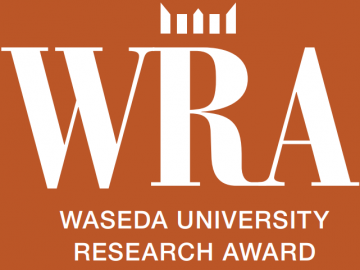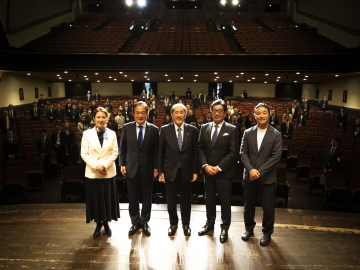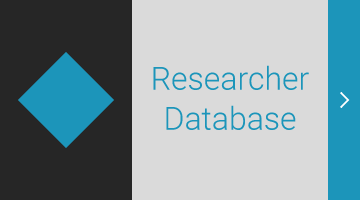Next-generation EMS researcher
Professor Yasuhiro Hayashi, Faculty of Science and Engineering
Next-generation Energy Management System (EMS) for maximum optimization
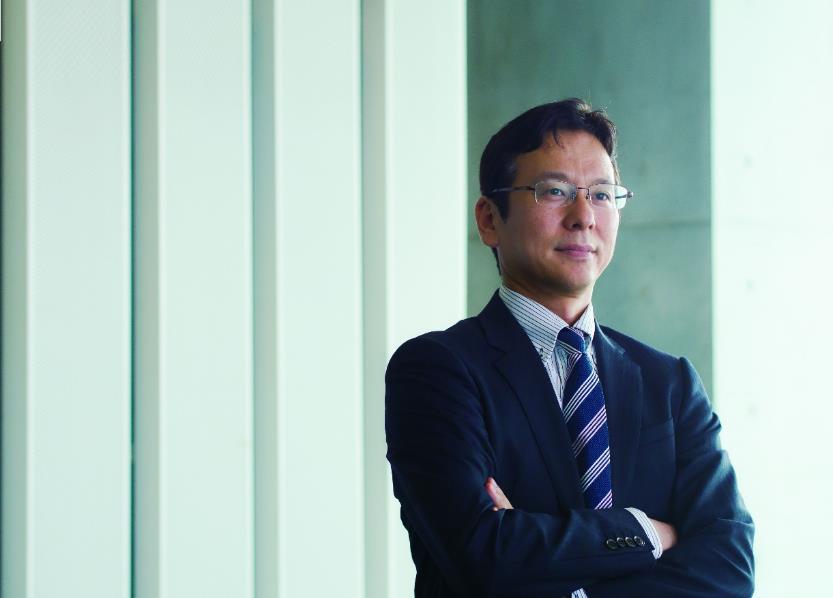
Data recorded in 2010 revealed that Japan supplied only 4.4% of its own energy. This is very low when compared to other advanced countries. Japan is not blessed with energy resources but on the other hand has the world’s most advanced electric power system and is a leader in national smart grids. With concerns of disputes escalating over resources, what is the ideal electric power system for the future? To answer this question, we asked Dr. Yasuhiro Hayashi, professor of the Department of Electrical Engineering and Bioscience, Graduate School of Advanced Science and Engineering, and Chairman of the Advanced Collaborative Research Organization for Smart Society at Waseda University to discuss the future’s electric power system.
The hopeful future for Japan’s electric power system
My research concerns next-generation Energy Management Systems (EMS) that provide complete optimization for the indispensable resource that is electricity.
Given Japan’s scarce natural resources, where will the country get its energy? When thinking about the electric power system of the future, we need to consider three aspects: power generation, transmission, and consumption. Relevant issues regarding each aspect are apparent: for power generation, the spread of renewable energy; for power transmission, the quality of smart grid transmission/distribution networks; and for consumption, smarter electricity consumption, otherwise known as demand response.
Currently, however, the electric power system in Japan tends to focus on specific optimization rather than total optimization due to the amount of different utilities involved. Thus, utilities engaged in renewable energy, electric companies promoting the use of smart grids, and manufacturers aiming for smarter electricity consumption are not aligned but taking different steps towards their goal. Under these circumstances, we cannot achieve complete optimization for the electric power system. We need to develop an energy management system (EMS) with a comprehensive vision of the electric energy flow from power generation, transmission, to consumption, while sharing essential information for complete optimization. From there, we must optimally manage energy based on grid, housing, building, and community. This is the focus of my research.
In terms of renewable energy, solar and wind power stations have been constructed nationwide, supported by the government buyback program. There are cases where the supply of renewable energy exceeds an electric company’s quota. How to handle this surplus electricity once solar power generation becomes even greater will need to be addressed. It will also be necessary to stabilize renewable energy, which fluctuates dramatically depending on the weather. We can overcome these issues by utilizing smart girds for local energy generation and local consumption.
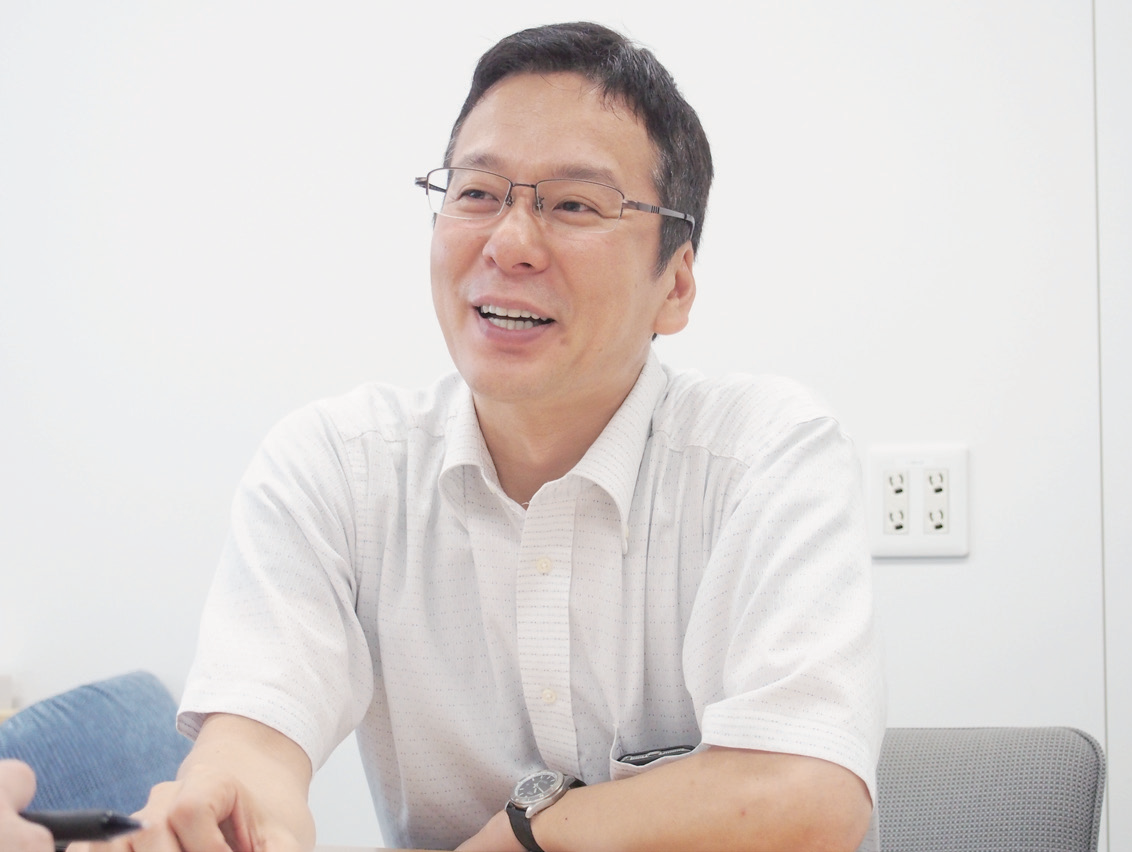
Professor Yasuhiro Hayashi in his research lab, smiling throughout the interview
As for consumption, we are experiencing a trend towards energy-saving home electronics and smart meters. As we go forward, we will need to address how to connect these products. We can maintain our comfortable lifestyles and continue to save energy through a Home Energy Management System (HEMS) that unifies control of home electronics, in addition to solar power generation, electric vehicles, batteries, and heat pump water heaters. This is the ideal future of electricity in Japan.
Control tower for next-generation EMS
The “Connect, Think and Operate” program is the key to the next-generation EMS. At most houses, the breaker would trip if, for example, you came home and used heat pumps to heat bath water while recharging your electric vehicle and using an IH cooking heater. HEMS can detect this, and reduce the amount of power recharging the electric vehicle charger. The program processes everything without any manual operation.
Thanks to the popularity of the IoT (Internet of Things), different pieces of equipment communicate with each other and have become interconnected. ECHONET Lite, the protocol required to accomplish this, has already been developed. What’s left is the “Connect, Think and Operate” program, which we are committed to creating.
EMS Shinjuku R&D Center, the main facility of the Research Institute for Advanced Network Technology (RIANT) of Waseda University where I serve as the Director, is not only the world’s most advanced state of the art research facility but also the only research facility capable of developing such a program. In order to develop the brain of the next-generation EMS, four smart houses were installed in the facility. Research activities associated with transmission/distribution networks are essentially conducted through simulations. This, however, has its limitations. It is impossible to perform an experiment using actual transmission/distribution networks. To address this limitation, the center built the world’s first smart grid simulator known as “Answer,” using electric wires of a few kilometers in length to represent installations such as houses, buildings, factories, solar power stations, wind power stations, and large batteries. We are attempting to reproduce fluctuations from unstable renewable energy in order to find the optimum control method and simulate demand response, the basis for next-generation EMS.
Click here for part 2 of this series
Profile
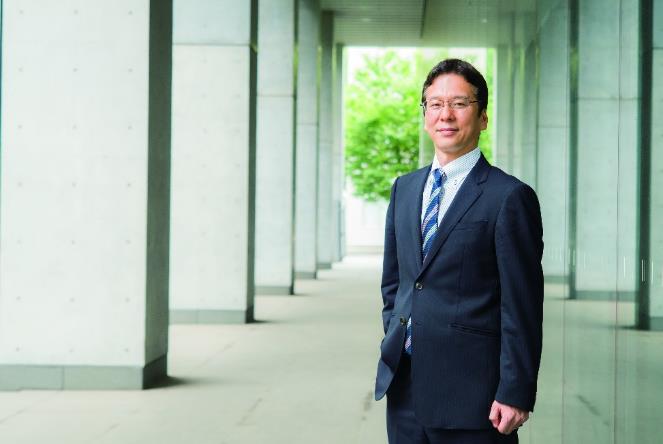
Yasuhiro Hayashi / Professor of the Department of Electrical Engineering and Bioscience, Graduate School of Advanced Science and Engineering, and Chairman of the Advanced Collaborative Research Organization for Smart Society
1989: Graduated from Waseda’s Department of Electric Engineering, School of Science and Engineering
1991: Graduated from Master’s Program at Waseda’s Graduate School of Science and Engineering
1994: Graduated from Doctoral Program at Waseda’s Graduate School of Science and Engineering where he obtained a doctorate in engineering
2009: Became a Professor at Waseda’s School of Advanced Science and Engineering after working as a lecturer at the Ibaraki University’s College of Engineering and an Associate Professor at University of Fukui’s Faculty of Engineering.
December 2009: Became Director of Research Institute for Advanced Network Technology (RIANT).
July 2014: Became Chairman of the Advanced Collaborative Research Organization for Smart Society (ACROSS).
Academic achievements
■ Recent media news
2015: ACROSS Chairman Hayashi selected as JST-CREST Strongest Team Research Director
■ Academic Papers
Distribution network verification for secure restoration by enumerating all critical failures
Inoue, T., Yasuda, N., Kawano, S., Takenobu, Y., Minato, S. I. & Hayashi, Y. 2015 Mar 1
IEEE Transactions on Smart Grid. 6, 2, p. 843-852
Distribution loss minimization with guaranteed error bound
Inoue, T., Takano, K., Watanabe, T., Kawahara, J., Yoshinaka, R., Kishimoto, A., Tsuda, K., Minato, S. I. & Hayashi, Y. 2014 Jan
IEEE Transactions on Smart Grid. 5, 1, p. 102-111
A versatile clustering method for electricity consumption pattern analysis in households
Hino, H., Shen, H., Murata, N., Wakao, S. & Hayashi, Y. 2013
IEEE Transactions on Smart Grid. 4, 2, p. 1048-1057
■ Publications
電力系統の最適潮流計算(日本電気協会)
スマートグリッドの構成技術と標準化(日本規格協会)
スマートグリッド学(日本電気協会新聞部)
■ Academic societies, government-related commissions
- Commissioner, Expert Committee on the Electric System Technology Survey for Achieving Smart Grid, The Institute of Electrical Engineers of Japan (2011–2013)
- Chair, the Smart Meter Scheme Study Group, METI (2010–) Chair, the Smart House Standardization Study Group, METI (2011–)
- Chair, the Smart House/Building Standardization and Business Promotion Study Group, METI (2012–)
- Commissioner, Working Group on System Design under the Electricity System Reform Subcommittee, Basic Policy Committee under the Advisory Committee for Natural Resources and Energy, METI (2013–)
- Trustee of Organization for Cross-regional Coordination of Transmission Operators, Japan (2015–)
Terminology
EMS: A mechanism to achieve optimum energy-saving by visualizing energy and making good use of power-generating units and batteries such as solar power generation. Divided into the following five control targets.
・HEMS (Home Energy Management System)
・BEMS (Building Energy Management System)
・FEMS (Factory Energy Management System)
・CEMS (Community Energy Management System)
・GEMS (Grid Energy Management System)
Smart grid: A power grid that enables optimization by controlling the flow of electricity from both the supply and demand sides by incorporating dedicated equipment and software. Garnered attention when it was introduced by the Obama Administration as a pillar of the US Green New Deal Program.
Renewable energy: Solar light, wind power, hydraulic power, geothermal heat, solar heat and atmospheric heat and other natural heat sources and biomass are specified by the law as having been “deemed to be used permanently as energy sources.”
Demand response: A mechanism to control use by reducing electricity consumption at peak hours for a stable electricity supply by setting hourly electricity rates and compensating consumers who reduce their use during peak hours.
Smart meter: An electricity meter that allows automation of monthly meter reading and visualization of electricity consumption status via HEMS, etc.
IoT (Internet of Things): A mechanism wherein everything is connected via Internet, allowing monitoring and controlling.
Protocol: An aggregate of predefined arrangements and procedures so that signals, data, and information can be transmitted mutually without delay.
ECHONET Lite: A communication protocol developed by the ECHONET Consortium. The control protocol and sensor net protocol for smart houses; standardized internationally as both ISO and IEC Standards.
Smart house: Housing where home electronics and system equipment are connected via informatization wiring, etc. for total optimization. Such housing controls energy equipment including solar power generation systems and batteries, home electronics, and housing equipment in the aim of energy management.

